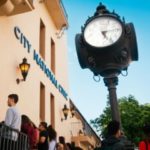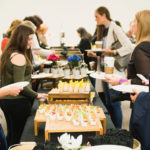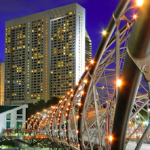I had no idea when my plane landed at O.R. Tambo International Airport in Johannesburg that I was arriving in the “cool capital of the Southern Hemisphere.” But after spending three days in the city for Meetings Africa 2016, I learned why the nickname, bestowed on South Africa’s capital city last December by the British edition of GQ magazine, is so apt.
Jozi — as the locals call it — is Africa’s leading business city, and brimming over with culture, ideas, and energy. Held Feb. 23–26 at the art-filled Sandton Convention Centre in suburban Sandton, Meetings Africa offered attendees the chance to see more of the destination at dinners, receptions, and other events held throughout Johannesburg, including at venues in inner-city Newton: Turbine Hall, a five-star event venue established in a refurbished power station, and the SAB (South African Breweries) World of Beer, a beer museum and conference venue.
‘THE CRADLE OF HUMANITY’
I was part of a group of international hosted media who stayed at Sun International’s The Maslow, a four-star business hotel with wrap-around terraces overlooking a pool and a velvety expanse of lawn. The Maslow, which has its own meeting and conference space, is within walking distance of the convention center, although construction around the center makes the hotel shuttle or cabs a better option for now.
Now in its 11th year, Meetings Africa drew more than 1,300 visitors, plus 206 international and regional hosted buyers and 274 exhibitors, including representatives from nine African tourist boards. Along with a robust trade show, the event was home to the first official education conference of the African Society of Association Executives (AFSAE), which held a ribbon-cutting ceremony for its Johannesburg office during Meetings Africa.
The role that business events play in spurring the production and transfer of knowledge also was on the agenda. South Africa has always been strong in scientific innovation and breakthroughs, according to Amanda Kotze-Nhlapo, chief convention bureau officer for the South African National Convention Bureau. “There are a lot of challenges in South Africa, and that actually makes us a very vibrant, innovative people,” Kotze-Nhlapo said. When it comes to hosting meetings and conferences, “we will come up with real solutions to real challenges that you will not necessarily get in the first world.”
For many people, traveling to Africa for a meeting presents a once-in-a-lifetime opportunity. Indeed, Kotze-Nhlapo said, the reaction when people learn that their organization will hold a meeting there is: “I can’t miss this meeting, because the destination is so unique.” She added: “This is the cradle of humanity. I think sometimes people find their souls here.”
A LEGENDARY RESORT
Approximately 80 percent of those who come to South Africa for meetings come early or extend their visit — and I was no exception. After Meetings Africa, I stayed on for a four-day press tour. The first stop on our itinerary was Sun City, less than two hours north of Johannesburg by car, at the edge of Pilanesberg National Park, South Africa’s third-largest game reserve.
Sun City was established four decades ago as a casino, and now includes nearly 1,000 guest rooms in four hotels, and a variety of indoor and outdoor meeting spaces, traversed by shuttles and a monorail. The resort is undergoing a renovation that includes the conference space in its hotels as well as its Entertainment Centre, and is due to be completed this year. Meanwhile, conferences and events can be accommodated at the Sun Sky Village, complete with meeting rooms and multifunction space.
We checked in to the resort’s most luxurious — and fanciful — hotel, The Palace of the Lost City. The 338-room, domed, turreted hotel is set in a botanical garden and comes with its own mythical backstory — it’s meant to be the legendary palace of a king who ruled over an ancient city destroyed by an earthquake. The hotel’s sleeping rooms and public areas are sumptuously furnished with zebra-print upholstery, carved wooden furniture, and acres of mosaics and frescoes. In the central Crystal Court dining room, where we dined on rack of lamb, arched windows frame a waterfall, and an enormous crystal chandelier hangs from the ceiling.
When a wakeup call came early the next morning, I was elated to see that it was only 4 a.m. We’d turned in after dinner with the understanding that if weather permitted, we would leave the hotel at 4:30 a.m. for a hot-air-balloon safari over Pilanesberg National Park. If not, the wakeup call would have come at 5 a.m.
It was dark with a full moon when we left the hotel and our driver handed out blankets for the short but chilly drive to the game park. We arrived at the launch site in time to see our pilot filling our balloon with hot air generated by bursts of propane, and we were aloft by sunrise, in a giant wicker basket that held 10 of us, plus the pilot. As we skimmed over the tops of thorn trees, our guide pointed out zebras, giraffes, wildebeests, rare white and black rhinoceroses, and pods of hippos. On the way back to our hotel, we spotted a young elephant not far from the road.
CITY BY THE SEA
From the resort, we headed back to Johannesburg, where we caught a two-hour flight to seaside Cape Town, which was to be our base for the next two nights. We checked in to the Century City Conference Centre and Hotel, which had opened just days earlier. The complex is part of a mixed-use development about 20 minutes outside downtown Cape Town that includes offices, residences, shopping, restaurants, and hotels built around an outdoor square.
The conference center’s multifunction event space and meeting rooms can accommodate groups of up to 1,900 people. I was particularly struck by the second-floor business lounge, which is open not just to conference attendees but also to locals for informal meetings, and serves lunch as well as snacks. Dinner was at the hotel’s Square Café & Wine Bar, where the menu included South African wines and inventive dishes such as pan-roasted duck breast with curried cauliflower and roasted grapes.
Our first stop the next morning was the Cape Town International Convention Centre (CTICC), in the city’s central business district. CTICC’s CEO, Julie-May Ellingson, led us on a hard-hat tour of the site where CTICC East is now under construction. Scheduled to open in early 2017, the expansion will add 110,000 square feet of multipurpose conference and exhibition space and more than 30,000 square feet of formal and informal meeting space.
From CTICC, we headed to the Victoria & Alfred Waterfront, which functions as a working harbor alongside a thriving shopping, entertainment, and dining district. Our group boarded two helicopters that gave us spectacular views of the harbor and Cape Town’s landmark Table Mountain as they ferried us to the Cape Winelands region.
The area’s vineyards were established in the 17th century by Dutch colonists. Today there are more than 100 wine estates offering tours and tastings, including historic properties that date to the 18th century. Our destination was the modern Cavalli Wine and Stud Farm, which includes event space, an art gallery featuring the works of leading South African contemporary artists, a tasting room, and the glass-walled Equus Restaurant.
Beautiful beaches line Cape Town’s Atlantic coast, and that evening we had dinner at The Bungalow, which combines fine dining with a laid-back beach vibe. Our reservations were timed to coincide with the sun setting over the ocean.
The next day, we took a ferry across the harbor to one of the city’s most visited sites: Robben Island, where Nelson Mandela was imprisoned for 18 years. Former political prisoners now conduct tours of the prison buildings on the island, sharing firsthand accounts of prison life.
We made a final stop at Baia Seafood Restaurant on Victoria Wharf. Our table overlooked the harbor, the perfect spot to drink in a final ocean view.





